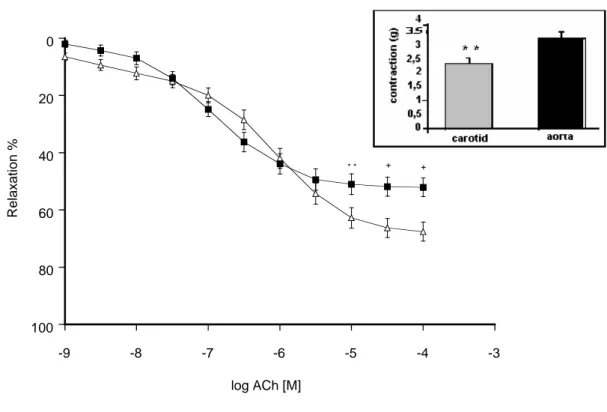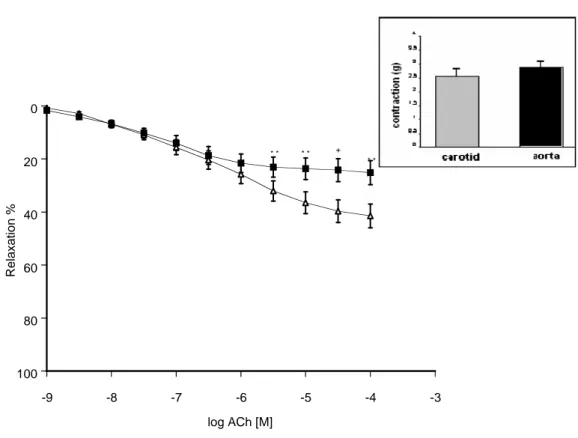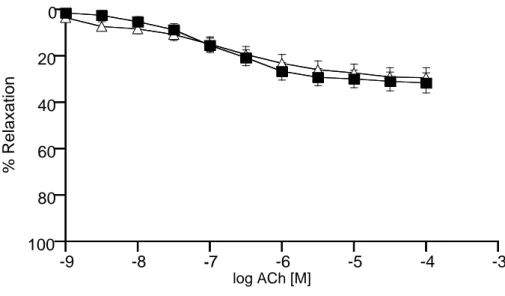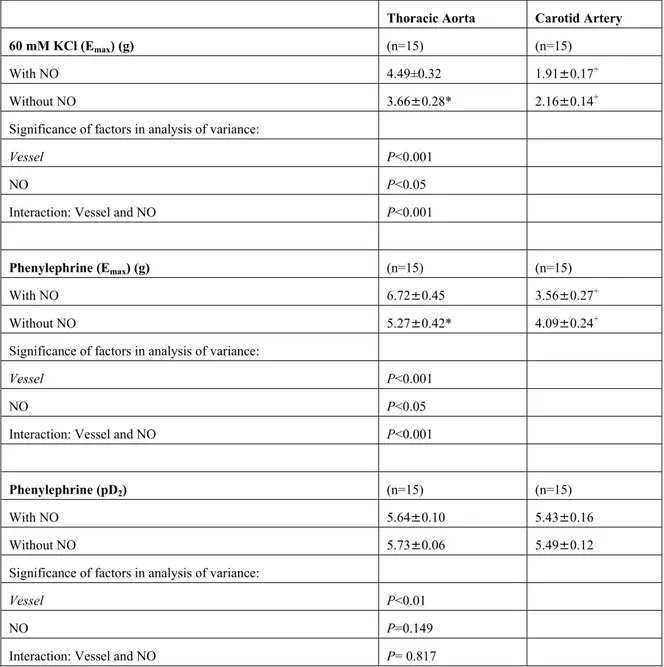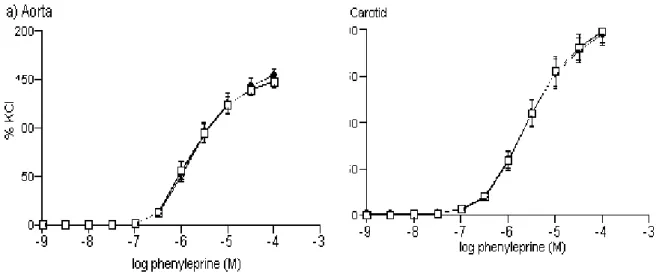DIFFERENT CONTRACTILE RESPONSES OF CAROTID ARTERY AND
THORACIC AORTA IN RABBITS
TAVŞANLARDA KAROTID ARTER VE TORASIK AORTANIN FARKLI KASILMA
YANITLARI
Gönen ÖZŞARLAK SÖZER*º, Zeliha KERRY
Ege University, Faculty of Pharmacy, Department of Pharmacology, 35100, Bornova-Izmir, TURKEY
ABSTRACT
Effects of inhibition of nitric oxide synthase by Nω-nitro L-argininee (L-NA) on acethylcholine (ACh)-induced relaxations, potassium chloride (KCl)- and phenylephrine (PH)-(ACh)-induced contractions on rabbit thoracic aorta and carotid artery were investigated. Rabbits (n=15) weighing 2-2.5 kg from both sex were used. A pair of thoracic aorta rings was isolated, as was a pair of carotid artery rings. One ring from each pair was treated with Krebs solution containing L-NA (0.1 mM) throughout the experiment and the other ring served as the control. Inhibition of nitric oxide synthesis by L-NA did not completely block ACh-induced relaxations in either artery. Inhibition of nitric oxide synthesis by L-NA significantly reduced 60 mM KCl-induced and (1nM- 0.1mM) PH-KCl-induced contractile responses in rabbit thoracic aorta whereas it did not affect these responses in carotid artery. Inhibition of nitric oxide synthesis by L-NA did not affect the sensitivity (pD2) to PH in any of the arteries . In conclusion, the results of the present study showed that
chronicle inhibition of nitric oxide synthesis by L-NA did not completely block nitric oxide-dependent relaxations in thoracic aorta and common carotid artery and decreased the contractile responses to PH and KCl only in thoracic aorta.
Key Words: rabbit, nitric oxide, Nω-nitro L-arginine (L-NA), vascular reactivity
Tavşan torasik aorta ve karotid arterinde nitric oksit sentezinin Nω-nitro L-arjinin (L-NA) ile inhibisyonunun asetilkolin (ACh) gevşeme ve potasyum klorür (KCl) ve fenilefrin (PH) kasılma yanıtları üzerine etkisi araştırıldı. Her iki cinsten (2-2.5 kg) ağırlığındaki tavşanlar (n=15) kullanıldı. 2’şer çift torasik aorta ve karotid arter ringi izole edildi. Her çiftin bir ringi deney boyunca L-NA (0.1 mM) içeren Krebs çözeltisi içerisinde tutuldu, diğer ring ise kontrol olarak işlev gördü. Nitrik oksit sentezinin L-NA ile inhibisyonu ACh gevşemelerini tamamen bloke etmedi. Nitirik oksit sentezinin L-NA ile inhibisyonu gerek 60 mM KCl, gerekse PH (1nM- 0.1mM) kasılma yanıtlarını torasik aortada anlamlı derecede azaltmasına rağmen, karotid arterde bu yanıtları etkilemedi. Her iki arterde de fenilefrin duyarlılığı nitrik oksit sentezinin L-NA ile inhibisyonundan bağımsızdı. Sonuç olarak, bu çalışmanın bulguları nitrik oksit sentezinin L-NA ile uzun süreli inhibisyonunun tavşan torasik aorta ve karotid arterde nitrik oksite bağlı gevşeme yanıtlarını tamamen bloke etmediğini ve torasik aortada PH ve KCl kasılma yanıtlarını azalttığını göstermektedir.
Anahtar Kelimeler: tavşan, nitrik oksit, Nω-nitro L-arjinin (L-NA), vasküler reaktivite * Corr
INTRODUCTION
ilator response of vessels to acetylcholine, referred to as ‘endothelial dysfun
ta and common carotid artery have b
of chronicle inhibition of nitric oxide synthesis by Nω -nitro-L-argi
the vessels were investigated. esponding author º M.Sc. Thesis
The attenuated vasod
ction’ has been shown to be associated with certain vascular diseases such as atherosclerosis, coronary heart disease and diabetes (1). During the last two decades, the nature of endothelial dysfunction in the development of atherosclerosis in human and in experimental models of animals has been widely investigated (2). It has generally been accepted that the attenuated vasodilator response reflects a defect that results in reduced generation and/or bioavailability of nitric oxide within either endothelial cells or underlying smooth muscle cells (3).
On the other hand, rabbit blood vessels especially thoracic aor
een widely used as basic tools to investigate nitric oxide-mediated relaxation mechanisms in experimental models of atherosclerosis in which endothelial dysfunction is a predominant feature (4, 5). In spite of the marked differences between the two vessels, both arteries are prone to development of atherosclerosis (6, 7).
In the present study, the effects
nine (L-NA) on the relaxation responses to acetylcholine were studied comparatively in rabbit thoracic aorta and common carotid artery. Moreover, under the inhibition of nitric oxide, a condition resembling endothelial dysfunction, the contractile responses to vasoconstictor agents of
MATERIALS AND METHODS
The animal experiments were carried out in accordance with guidelines described by the
Ethics acy, Ege University.
ital (35 mg/kg, i.v.). After careful remov
aximal effect (Emax)
d for vessel (thoracic aorta or carotid
Committee of the Faculty of Pharm
Common carotid arteries and thoracic aortas were obtained from white rabbits of either sex (2 - 2.5 kg) that were exanguinated under sodium pentobarb
al of loose connective tissue 2 adjacent pairs of rings 3-4 mm long from both common carotid artery and thoracic aorta were cut. Care was taken not to cause damage to the endothelium. Then the rings were suspended in organ chambers filled with physiological salt solution (Krebs) at 370C, continuously oxygenated with 95%O
2 - 5%CO2. In order to examine the effects of the
inhibition of nitric oxide synthesis on the contractile activities Nω-nitro-L-arginine (Acros
Organics®) (NA, 0.1mM) was added to Krebs solution (one ring with NA; one ring without L-NA from each vessel). Isometric contractile force development was measured by means of a Grass FT3 force transducer and recorded (Polywin95 1.0. Commat, Ankara, Turkey) by means of a microcomputer (IBM PS/1). After 15-min equilibration, carotid artery and thoracic aorta rings were gradually stretched to a tension of 7 and 4 g, respectively, as previously determined optimum resting tensions based on the length tension relationship, and left to equilibrate for 45 min longer. At the end of the equilibration period, the rings were stimulated with 10 µM phenylephrine (Merck®) and quickly washed with physiological salt solution (PSS) 3 times. The preparations were then allowed a further 30 min of equilibration time. Then rings were contracted using 60 mM potassium chloride (Merck®) and washed again. Following this, the rings were contracted by phenylephrine (0.1 µM) and when a steady tension level was reached, acetylcholine (Merck®) was added in a cumulative manner (1 nM - 0.1 mM). After washing with PSS three times, cumulative phenylephrine (1 nM - 0.1 mM) dose-response curves were constructed in each ring.
Shown are means±s.e.m; n indicates the number of animals. Significance was accepted at
P=0.05. The negative logarithm of the concentration (pD2) that produced half of the m
of that agonist was calculated using linear regression analysis (Polywin95, 1.0, Commat, Ankara, Turkey). Means of pD2 and Emax values were compared. Acetylcholine-induced
relaxations were normalized to the initial phenylephrine contraction.
Statistical analyses of data were performed with a factorial analysis of variance (ANOVA) for repeated measurements. ANOVA analysis of data were evaluate
there were interactions between the factors in ANOVA, Student’s t test was used for paired comparisons.
RESULTS AND DISCUSSION
rings to acetylcholine in the presence of an intact endoth
choline-induced relaxa
Vasorelaxant responses of the
elium- Acetylcholine induced concentration-dependent relaxations in both thoracic aorta and carotid artery rings precontracted with 1 µM phenylephrine (PH) (Figure 1). Statistical analysis showed that the Emax values of acetylcholine-induced concentration-dependent relaxations of
common carotid artery rings were greater than those of thoracic aorta rings (Table 1). Besides, the sensitivity of the vessels to ACh, as reflected by pD2 values, was found to be statistically different
between the vessels, being less sensitive in common carotid artery rings (Table 1). Effects of inhibition of nitric oxide synthesis with L-NA on acetyl
tions in common carotid artery and thoracic aorta- In spite of the inhibition of nitric oxide synthesis with L-NA (0.1 mM) acetylcholine induced concentration-dependent relaxations in both thoracic aorta and carotid artery rings precontracted with 0.1 µM phenylephrine (Figure 2). The Emax and pD2 values of these relaxation responses to ACh showed that there were statistical
differences between the vessels (Table 1). In order to elucidate the degree of NO-dependent relaxations in relation to the entire endothelium-dependent relaxations in thoracic aorta and carotid artery rings, the data of concentration – response curves to ACh in the presence of L-NA were subtracted from data obtained from the rings with an intact endothelium (Figure 3). There was no statistical difference between the subtracted concentration – response curves of ACh from carotid artery and thoracic aorta rings (Figure 3).
0 20 40 60 80 100 -9 -8 -7 -6 -5 -4 -3 Relaxation % log ACh [M] + + * *
Figure 1: ACh-induced relaxations in thoracic aorta (■) and carotid artery (∆) rings in the absence of NO
inhibition with L-NA (0.1 mM) (thoracic aorta n=15; carotid artery n=15). The responses are shown as means±s.e.m. and expressed as % of initial contraction to PH (1 µM). Insert: Initial contractions elicited by 1 µM PH in thoracic aorta and carotid artery rings are shown (*P<0.05, **P<0.01, +P<0.001, Student’s t test, paired data).
Potassium chloride-induced (60 mM) contractile responses in common carotid artery and thoracic aorta rings- Potassium chloride (60 mM) induced contractions either in the presence of an intact endothelium or L-NA (0.1 mM) in common carotid artery and thoracic aorta rings (Table 2). Carotid artery rings developed significantly less tension (Emax) in response to KCl than did thoracic
aorta rings. As indicated with the presence of an interaction between the vessel and NO (Table 2, p<0.001), the contractile responses of the vessels were found to be significantly different in the presence and absence of inhibition of NO. Statistical analysis revealed that the presence of L-NA did not effect KCl-induced contraction in carotid artery while it decreased contractions of this agent in thoracic aorta rings (Table 2).
0 20 40 60 80 100 -9 -8 -7 -6 -5 -4 -3 Relaxation % log ACh [M] * * + * * * *
Figure 2: ACh-induced relaxations in thoracic aorta (■) and carotid artery (∆) rings in the presence of NO
inhibition with L-NA (0.1 mM) (thoracic aorta n=15; carotid artery n=15). The responses are shown as means±s.e.m. and expressed as % of initial contraction to PH (1 µM) (*P<0.05, **P<0.01, +P<0.001, Student’s t test, paired data). Insert: Initial contractions elicited by 1 µM PH in thoracic aorta and carotid artery rings are shown.
Table 1: The Emax (%) and the pD2 values of ACh-induced relaxations in thoracic aorta and carotid artery rings in
the presence and absence of NO inhibition with L-NA (0.1 mM). In the presence of NO inhibition with
L-NA In the absence of NO inhibition with L-NA
Emax (%) (n=15) pD2 (n=15) Emax (%) (n=15) pD2 (n=15) Thoracic Aorta 25.4±1.4* 7.18±0.14** 56.9±4.1** 6.91±0.13** Carotid Artery 45.3±3.8 6.24±0.12 72.7±2.8 6.54±0.14
Shown are means±s.e.m. n represents the number of rabbits used.* and ** denotes the significant difference from carotid artery (*P<0.01, **P<0.001, Student’s t test, paired data).
0 20 % Relaxatio n 40 60 80 100 -3 -9 -8 -7 -6 -5 -4 log ACh [M]
Figure 3: Substracted concentration – response curves of curves to ACh in the presence of L-NA subtracted from
the curves to ACh obtained from the rings with an intact endothelium in thoracic aorta (■) and carotid artery (∆). (thoracic aorta n=15; carotid artery n=15). The responses are shown as means±s.e.m. and expressed as % of initial contraction to PH (1 µM).
Phenylephrine-induced contractile responses in common carotid artery and thoracic aorta rings- Phenylephrine (1 nM - 0.1 mM) induced contractions either in the presence of an intact endothelium or L-NA (0.1 mM) in common carotid artery and thoracic aorta rings (Figure 4). Carotid artery rings developed significantly less tension (Emax) in response to phenylephrine (1 nM
- 0.1 mM) than did thoracic aorta rings (Figure 4, Table 2). Similar to KCl responses, as indicated by the presence of an interaction between the vessel and NO (Table 2, p<0.001), the contractile responses of the vessels were found to be significantly different in the presence or absence of inhibiton of NO by L-NA. Again, as seen in KCl-induced contractions, statistical analysis revealed that the presence of L-NA did not effect phenylephrine-induced contraction in carotid artery while it decreased the contractions of this agent in thoracic aorta rings (Table 2, Figure 4).
Table 2: The Emax values of KCl- and PH-induced contractions, and pD2 values of PH-induced contractions in thoracic aorta and carotid artery rings in the presence and absence of NO inhibition with L-NA (0.1 mM)
Thoracic Aorta Carotid Artery
60 mM KCl (Emax) (g) (n=15) (n=15)
With NO 4.49±0.32 1.91±0.17+
Without NO 3.66±0.28* 2.16±0.14+
Significance of factors in analysis of variance:
Vessel P<0.001
NO P<0.05
Interaction: Vessel and NO P<0.001
Phenylephrine (Emax) (g) (n=15) (n=15)
With NO 6.72±0.45 3.56±0.27+
Without NO 5.27±0.42* 4.09±0.24+
Significance of factors in analysis of variance:
Vessel P<0.001
NO P<0.05
Interaction: Vessel and NO P<0.001
Phenylephrine (pD2) (n=15) (n=15)
With NO 5.64±0.10 5.43±0.16
Without NO 5.73±0.06 5.49±0.12
Significance of factors in analysis of variance:
Vessel P<0.01
NO P=0.149
Interaction: Vessel and NO P= 0.817
Shown are means±s.e.m. n represents the number of rabbits used. Because of the interactions between vessel and NO, Student’s t test was performed for paired data. * without NO vs with NO in rings from thoracic aorta (p<0.05); +
Figure 4: PH-induced contractions in thoracic aorta and carotid artery rings in an intact endothelium (■) and in
the presence of NO inhibition with L-NA (0.1 mM) (∆) (thoracic aorta n=15; carotid artery n=15). The responses are shown as means±s.e.m. (*P<0.05, **P<0.01, +P<0.001, Student’s t test, paired data)
Figure 5: PH-induced contractions when normalized to KCl (60 mM) contractions in thoracic aorta and carotid
artery rings in an intact endothelium (●) and in the presence of NO inhibition with L-NA (0.1 mM) (□) (thoracic aorta n=15; carotid artery n=15). The responses are shown as means±s.e.m.
When phenylephrine-induced contractions were normalized to KCl (60 mM) contractions in carotid artery and thoracic aorta, no statistical differences were observed between the curves obtained in the presence or absence of inhibition of NO by L-NA (Figure 5).
In terms of pD2 values of phenylephrine-induced (1 nM - 0.1 mM) contractions thoracic aorta
was found to be more sensitive than carotid artery in both absence and presence of nitric oxide (Table 2).
In the present study, the effect of inhibition of nitric oxide synthesis by L-NA (0.1 mM) on acetylcholine-induced relaxation and KCl- and phenylephrine-induced contractile responses were investigated in rabbit vessels and common carotid artery and thoracic aorta were compared. Since common carotid artery and thoracic aorta have been widely used in experimental models of atherosclerosis, the results of the effects of chronic inhibiton of nitric oxide synthesis on the vascular responses may reflect the features of a dysfunctional endothelium for future studies.
We observed a difference in the Emax values of acetylcholine-induced relaxations between
thoracic aorta and carotid artery. This result suggests that different levels of phenylephrine-induced precontractions in thoracic aorta and carotid artery rings may result in the higher ACh-induced relaxation in carotid artery. However, van Put et al. (8) showed that initial contractions at different magnitudes induced by different concentrations of phenylephrine did not affect Emax and pD2 values
of ACh-induced relaxations in rabbit carotid arteries. Hence, in the present study, as indicated by the higher pD2 values of ACh in thoracic aorta, the different Emax values of this agent between the
vessels may result from dissimilar density of muscarinic receptors in endothelium in thoracic aorta and carotid artery (9, 10).
Consistent with our findings, in a number of studies it has been shown that NO synthase inhibitors failed to completely block endothelium dependent relaxations in various vascular tissues (11, 12). Similarly, in some studies, ACh-induced relaxations have been shown in blood vessels from endothelial nitric oxide synthase knockout mice (13).
As seen in the absence of L-NA, the Emax values of ACh-induced relaxations in common
carotid artery were found to be greater than those of thoracic aorta in the presence of L-NA, suggesting that L-NA does not interfere with muscarinic receptors in these vessels. However, subtracted concentration-response curves of acetylcholine-induced relaxations were not significantly different between carotid artery and thoracic aorta. This may reflect the equal contribution of nitric oxide-induced relaxations to the endothelium-derived relaxations in both arteries. On the other hand, a higher pD2 value to ACh in thoracic aorta as compared to carotid
artery in the absence of NO inhibition is still persistent in the presence of L-NA, suggesting an effect of chronic inhibition of NO with L-NA. However, this increased sensitivity is inconsistent with the results from studies pointing out the decreased sensitivity to ACh in the presence of a dysfunctional endothelium, as observed in early atherosclerosis models (14, 15).
The finding of the present study demonstrated that the contractile responses to potassium chloride differ between the vessels and inhibition of nitric oxide synthesis attenuates these responses only in thoracic aorta. The different contractile responses to potassium chloride between thoracic aorta and carotid artery may result from the difference in contractile machinery and/or the amount of smooth muscle tissue (16).
The increased responsiveness of the contractile agonists after endothelial removal and/or inhibition of nitric oxide synthesis is a well known phenomenon (17, 18). In the present study, taking into consideration that potassium chloride is a non-receptor contractile agonist, the reduced responsiveness in thoracic aorta to this agent suggests the possibility that chronic inhibition of nitric oxide may interfere with the voltage-dependent calcium channel in thoracic aorta. Similarly, inhibition of NO synthesis attenuated phenylephrine-induced Emax responses, an α1-adrenergic
receptor agonist, only in thoracic aorta but not in carotid artery. Since we did not use a cyclooxygenase inhibitor in organ chambers, it is possible that increased release of prostacyclin or other prostaglandins and/or Endothelium-derived Hyperpolarizing Factor (EDHF) in response to chronicle nitric oxide inhibition may be responsible for the decreased contractile responses in thoracic aorta (19, 20, 21).
On the other hand, it is worth noting that in spite of the decreased contractile responses to phenylephrine in thoracic aorta in the presence of NO inhibition, the sensitivity of the vessels to this agent was not affected by this inhibition, suggesting that NO inhibition does not interfere with α1-adrenergic-mediated responses. Furthermore, when the contractile responses to phenylephrine
were normalized to KCl-induced contractions in each vessel, no statistical differences were observed between the curves obtained in the absence or presence of NO inhibition, indicating a non-receptor-mediated effect of L-NA to the reduced responsiveness of thoracic aorta to these contractile agonists.
In conclusion, the results of the present study showed that chronicle inhibition of nitric oxide synthesis by L-NA did not completely block nitric oxide-dependent relaxations in thoracic aorta and common carotid artery and decreased the contractile responses to phenylephrine and potassium chloride only in thoracic aorta.
ACKNOWLEDGEMENTS
This study was supported by Ege University Research Found (Project No: 99 ECZ 006). REFERENCES
1. Mombouli, J-V. & Vanhoutte, P. M., “Endothelial dysfunction: From physiology to therapy”
J. Mol. Cell Cardiol., 31, 61-74 (1999).
2. Rubio, A. R. & Morales-Segura, M. A. “Nitric oxide, an iceberg in cardiovascular physiology: Far beyond vessel tone control” Arch. Med. Res., 35,1-11 (2004)
3. Busse, R. & Fleming, I. “Regulation of endothelium-derived vasoactive autacoid production by hemodynamic forces” TIPS, 24, 24-29 (2003).
4. Laight, D.W., Matz, J., Caesar, B., Carrier, M.J., Anggard, E. “Investigation of endogenous nitric oxide vascular function in the carotid artery of cholesterol-fed rabbits” Br.
J. Pharmacol., 117, 1471-1474 (1996).
5. Weisbrod, R. M., Griswold, M. C., Du, Y., Bolotina, V. M., Cohen, R. A. “Reduced responsiveness of hypercholesterolemic rabbit aortic smooth muscle cells to nitric oxide”
Arterioscler Thromb Vasc. Biol., 17, 394-402 (1997).
6. Minor, R.L., Jr. Meyers, P.R., Guerra, R. Jr., Bates, J. N., Harrison, D.G., “Diet-induced atherosclerosis increases the release of nitrogen oxides from rabbit aorta” J. Clin. Invest., 86, 2109-2116 (1990).
7. Najibi, S., Cowan, C.L., Palacino, J.J., Cohen, R.A., “Enhanced role of potassium channels in relaxations to acetylchloline in hypercholesterolemic rabbit carotid arteries” Am. J.
Physiol. 266, H2061-H2067 (1994).
8. Van Put, D.J.M., Van Hove, C.E., De Meyer, G.R.Y., Wuyts, F., Herman, A.G., Bult, H., “Dexamethasone influences intimal thickening and vascular reactivity in the rabbit collared carotid artery” Eur. J. Pharmacol., 294, 753-761 (1995).
9. Christie, M.I., Lewis, M.J., “Vascular smooth muscle sensitivity to endothelium-derived relaxing factor is different in different arteries” Br. J. Pharmacol., 95, 630-636 (1988). 10. Crauwels, H. M., Van Hove, C.E., Herman, A. G., Bult H., “Heterogeneity in relaxation
mechanisms in the carotid and the femoral artery of the mouse”, Eur. J. Pharmacol., 404, 341-351 (2000).
11. Nagao, T., Vanhoutte, P.M., “Characterizaiton of endothelium-dependent relaxations resistant to nitro-L-argininee in the porcine coronary artery” Br. J. Pharmacol., 107 (4), 1102-7 (1992).
12. Brandes, R.P., Schmith-Winnenthal, F.H., Feletou, M., Gödecke, A., Huang, P.L., Vahoutte, P.M., Fleming, I., Busse, R., “An endothelium-derived hyperpolarizing factor distinct from NO and prostacyclin is a major endothelium-dependent vasodilator in resistance vessels of wild-type and endothelial NO synthase knockout mice”, Proc. Natl.
Acad. Sci. USA, 97, ,9747-9752 (2000).
13. Chataigneau, T., Feletou, M., Huang, P.L., Fishman, M.C., Duhault, J., Vanhoutte, P.M., “Acetylcholine-induced relaxation in blood vessels from endothelial nitric oxide synthase knockout mice”, Br. J. Pharmacol., 126, 219-226 (1999).
14. Verbeuren, T,J, Jordaens, F.H., Van Hove, C.E., Coene, M.C., Herman, A.G., “Effect of hypercholesterolemia on the vascular reactivity in the rabbit”, Circ. Res., 58, 552-564 (1986).
15. Yasa, M., Kerry, Z., Yetik, G., Sevin, G., Reel, B., Ozdemir, N., Erhan, Y., Ustunes, L., Berkan, T., Ozer, A., “Effects of treatment with FK409, a nitric oxide donor, on collar-induced thickenening and vascular reactivity”, Eur. J. Pharmacol., 374, 33-39 (1999). 16. Kuriyama, H., Kitamura, K., Nabata, H., “Pharmacological and physiological significance
of ion channels and factors that modulate them in vascular tissues” Pharm. Rev., 47, 387-573 (1995).
17. Criscione, L., Müller, K., Prescott, M.F., “Endothelial cell loss enhances the pressor response in resistance vessels”, J. Hypertension, 2 (suppl 3), 441-444 (1984)
18. De Meyer, G.R.Y., Bult, H., Üstünes, L., Kockx, M., Jordaens, F.H., Zonnekeyn, L.L., Herman, A.G., “Vasoconstrictor responses after neo-intima formation and endothelial removal in the rabbit carotid artery”, Br. J. Pharmacol.,112, 471-476 (1994).
19. Randall, M.R. ”The other EDRF”, TIPS, 19, 37-38 (1998).
20. Marcelin-Jimenez, G. & Escalante, B., “Functional and cellular interactions between nitric oxide and prostacycline” Com. Biochem Physiol., 129, 349-359 (2001).
21. Vanhoutte P. M. “Endothelium-dependent hyperpolarizations: The history” Pharmacol. Res. 49, 503-508 (2004).
Received: 26.04.2005 Accepted: 17.05.2005
